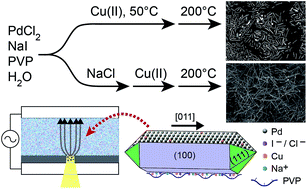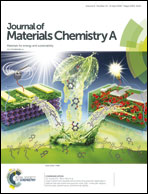Copper- and chloride-mediated synthesis and optoelectronic trapping of ultra-high aspect ratio palladium nanowires†
Abstract
We present a scalable hydrothermal synthesis of one-dimensional palladium nanostructures from palladium(II) chloride precursor, mediated by the introduction of low concentrations of copper(II) ions and/or sodium chloride. Adding Cu at a molar ratio of ∼1 : 12 500 relative to Pd increases the yield of 1D nanostructures from 10% to 90%. Furthermore, NaCl enhances 1D nanostructure growth such that high yields of long Pd nanowires (PdNWs)—featuring the highest aspect ratios yet reported for solution-grown Pd nanocrystals, with diameters of 20 nm and lengths up to 7 μm—can be achieved in a third of the time required for the synthesis with Cu alone. X-ray diffraction, electron microscopy, and X-ray photoelectron spectroscopy measurements confirm that the as-synthesized nanowires are indeed metallic crystalline Pd with a 5-fold twinned cross-section. It is hypothesized that the Cu ions scavenge oxygen to suppress etching of the twinned Pd seeds that eventually grow into elongated structures, whereas NaCl improves the solubility of PdCl2 and lowers the reduction rate via formation of the PdCl42− complex, promoting diffusional growth. The high aspect ratio of the PdNWs facilitates their manipulation in an optoelectronic tweezers (OET) device, which we demonstrate as a way to enhance their applicability for catalysis and hydrogen sensing.



 Please wait while we load your content...
Please wait while we load your content...
